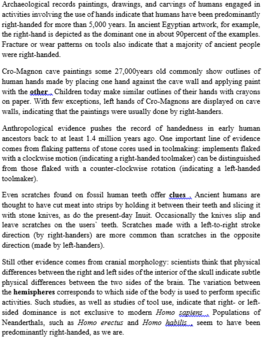Read the following passage and mark the letter A, B, C, or D on your answer sheet to indicate the correct answer to each of the questions from 36 to 42.
In Africa, people celebrate with joy the birth of a new baby. The Pygmies would sing a birth-song to the child. In Kenya, the mother takes the baby strapped to her back into the thorn enclosure where the cattle is kept. There, her husband and the village elders wait to give the child his or her name.
In West Africa, after the baby is eight days old, the mother takes the baby for it's first walk in the big, wide world, and friends and family are invited to meet the new baby. In various African nations, they hold initiation ceremonies for groups of children instead of birthdays. When children reach a certain designated age, they learn the laws, beliefs, customs, songs and dances of their tribes, Some African tribes consider that children from nine to twelve are ready to be initiated into the grown up world. They may have to carry out several tests.
Masai boys around thirteen years old to seventeen undergo a two stage initiation. The first stage lasts about three months. The boys leave their parents' homes, paint their bodies white, and are taught how to become young warriors. At the end of this stage, they have their heads shaved and they are also circumcised. The second stage, the young warriors grow their hair long and live in a camp called a manyatta where they practice hunting the wild animals that might attack the Masai herds. This stage may last a few years. When they are ready, they will marry and become owners of large cattle herds like their fathers.
The girls are initiated when they are fourteen or fifteen. They are taught by the older women about the duties of marriage and how to care for babies. Soon after that they are married and lead a life similar to that of their mothers.
Question 37: Where do the father and older villagers in Kenya give the name to the child?
A. in the village
B. at the place to keep the cattle
C. at their house
D. at the fence of the cattle's cages.






Đáp án B
Người cha và những người lớn tuổi trong làng ở Kenya thường đặt tên cho đứa trẻ ở đâu?
A. ở trong làng B. tại nơi chăn nuôi gia súc
C. ở nhà nọ D. tại hàng ròa của chuồng gia súc
Căn cứ vào thông tin đoạn 1:
In Kenya, the mother takes the baby strapped to her back into the thorn enclosure where the cattle is kept. There, her husband and the village elders wait to give the child his or her name.
(Ở Kenya, người mẹ đưa em bé được địu vào lưng mình vào trong vùng đất có rào gai vây quanh, nơi gia súc được nuôi. Ở đó, chồng bà và những người lớn tuổi trong làng chờ đợi đểđặt tên cho đứa tré.)